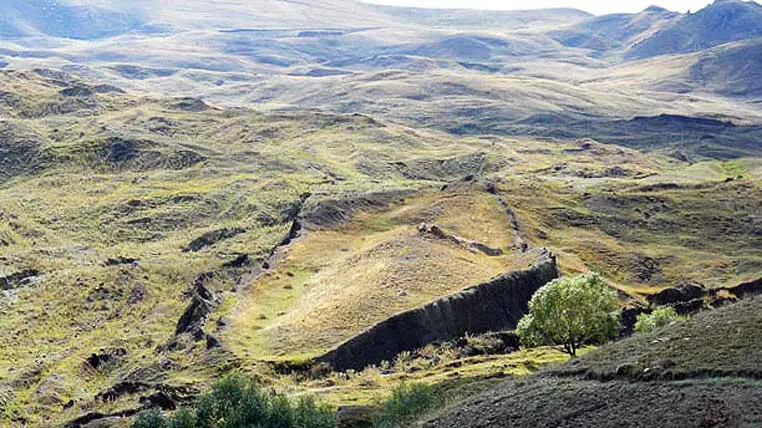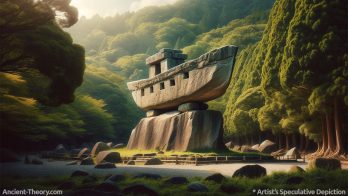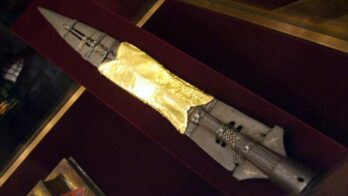Noah’s Ark is one of the most enduring tales in the history of humankind, a story that has fascinated people across the globe for centuries.
The epic tells how, disappointed with humanity’s wickedness, God decided to cleanse the world with a massive flood.
Noah, a righteous man, was chosen to construct a giant vessel to house two of every kind of animal and his family to survive the deluge.
However, despite its enduring popularity, the exact location of Noah’s Ark still needs to be discovered, and there is much debate about whether the story is based on fact or merely a myth.
The Impossible Measurements of Noah's Ark
According to the Bible’s Old Testament, God instructed Noah to take his wife, his sons, and their wives and build an ark on which to bring two of each species of animal, bird, insect, or other living things.
God commanded them to use gopher wood for the construction of the ark.
Strangely enough, the Hebrew term “gopher” is unique in Tanakh and practically impossible to translate accurately.
Several linguists translated “gopher” as “willow,” while others as “cedar” or “pine,” yet there is no consensus on its exact meaning.
Furthermore, Noah received exact instructions from God regarding the ark’s measurements.
According to the Old Testament in the book of Genesis, Noah’s Ark was said to be 300 cubits long, 50 cubits wide, and 30 cubits high.
A cubit is an ancient measurement unit commonly used in the Middle East during biblical times. It is generally considered the distance from a person’s elbow to the tip of their middle finger.
When Noah’s Ark was supposedly built, two important measurement systems were in place: Egyptian and standard.
According to the Egyptian system, one royal Egyptian cubit was equal to 20.8 inches or 52.9 centimeters. In this case, Noah’s Ark would have measured approximately 520 feet (158 meters) in length, 86 feet (26 meters) in width, and 52 feet (15.87 meters) in height.
According to the standard system (widely used throughout the Ancient world), one cubit was approximately 18 inches or 45 centimeters. In this case, the dimensions of Noah’s Ark were about 450 feet (137 meters) long, 75 feet (23 meters) wide, and 45 feet (14 meters) high.
However, regardless of which system was used to calculate Noah’s Ark size, the ship would have been the largest wooden vessel ever built.

The Biblical Flood: Theories and Debates
According to the Old Testament, the biblical flood occurred in 2345 BC and lasted 40 days and 40 nights. It rained incessantly, the seas and oceans spilled over the land, and the waters rose and covered villages and cities, drowning all human breath.
When the waters began to recede, Noah’s Ark came to rest on the crest of Mount Ararat, a mountain range on the border between Turkey and Armenia.
Interestingly, Ararat is the ancient name of the region where Armenia is today, and the name was not linked to this mountain until the 11th century.
In the biblical episode recounting the flood, we read:
After one hundred and fifty days had passed, the water on the earth began to recede, and in the seventh month, on the twenty-seventh day of the month, the ark came to rest on the mountains of Ararat. The water continued to go down until the tenth month; in the tenth month, on the first day of the month, the tops of the mountains were seen.
Genesis 8:3-5
However, no clear evidence supports this story, and most experts argue that a flood of such magnitude never occurred.
The scientific community also contests the existence of Noah’s Ark, citing several controversies surrounding the boat’s dimensions, as recorded in the Bible.
For instance, Noah’s Ark would have been the largest wooden vessel ever constructed, a task only possible with the help of hundreds, if not even thousands of workers.
Furthermore, it is unlikely that a vessel of such size, made entirely of wood, could float.
Finally, the ark would have had to accommodate hundreds of thousands of species of birds, animals, and insects, along with sufficient food and water to sustain them.
Most experts consider the biblical flood just one of the many legends about catastrophic floods that allegedly took place a very long time ago.
These legends, however, do not constitute evidence of a universal flood. Instead, most legends originate from the devastating torrents that have affected and continue to affect many areas of the world.
These “apocalyptic floods” terrorized local communities comprised entirely of highly superstitious people, who interpreted them as evidence of the gods’ wrath.
Despite these logical explanations, some fundamentalists continue to search for the remains of Noah’s Ark on Mount Ararat.
But even the exact location where the alleged ark might be is uncertain.
For instance, the Quran mentions Mount Judi, south of the Ararat mountain range, as the stopping point of the famous ark.
Historian Flavius Josephus, who lived in the first century, believed the wreckage should be searched for in Haran, a Turkish village near the Syrian border.
Other chroniclers mention other possible locations where the ark might have run aground, most in Turkey, Armenia, Iran, and Greece.
Therefore, the biblical story of an ark stranded on Mount Ararat is doubtful.
Nonetheless, most Christians and Jews remain convinced that the remains of Noah’s Ark are somewhere on the crests of Ararat.
For instance, Sir John Mandeville, the author of travel books usually signed with a pseudonym, repeatedly claimed that on clear, sunny days, the remains of Noah’s Ark could be seen with the naked eye on the northern slope of the mountain.
In Search of Noah's Ark
In 1670, a Dutch merchant named Jan Struys was captured and held captive by Armenian bandits. During his captivity, Struys met a hermit on Mount Ararat.
The old hermit was exhausted and struggling with numerous health issues, and Struys used his medical knowledge to look after him, helping him to recover.

In gratitude, the old man offered him an unusual gift – “a piece of black, hard wood” and a sparkling stone which “he said he took from under the ark.”
In the early 1800s, an expedition was organized to the mountain, attended by historians, archaeologists, and researchers. However, the experts failed to find evidence of Noah’s Ark on the mountain.
In 1876, James Bryce, a professor at Oxford, discovered a piece of wood approximately one meter in length near the peak of Great Ararat. Bryce argued that the wood was part of Noah’s Ark.
Hoaxes and Disappointing Results
On August 10, 1883, the “Chicago Tribune” newspaper published an article about the ark.
Here is a fragment from that article:
A newspaper from Constantinople reports that Noah’s Ark has been discovered. The Turkish authorities have formed a commission to investigate the avalanches that occurred on Mount Ararat. The analysis group identified a massive black wooden structure emerging from the glacier by chance. The authorities questioned the locals and found out that the people had discovered the skeleton of Wood six years ago. Still, they were afraid to approach the wreck because, they said, a spirit with a terrifying appearance showed itself at one of the upper windows each time. However, the Turkish researchers are daring and not intimidated by such superstitions and decided to reach the wreck at all costs.
But what actually happened? Let’s analyze some of the facts.
Although they faced extraordinary difficulties on their way to the top, the authorities, accompanied by a small group of researchers, managed to reach the wreckage.
Located on the western slope of Great Ararat Peak, the wreckage revealed a construction of enormous difficulty. The “ark” was well preserved, and some expedition members immediately acknowledged it as Noah’s Ark.
The group also included an English speaker who was knowledgeable in Bible verses.
He immediately concluded that the “ark” had been built from gopher lumber, the mysterious biblical wood obtained from a tree that only grows in the Euphrates region.
Then, the group entered the brown-colored structure.
They observed the interior, noting that the “ark” was divided into compartments of 15 feet (approximately 4.5 m) in height, which could have allowed the transportation of large animals.
However, they could only explore the first three compartments because the rest of the structure was covered with ice; therefore, they could not determine how deep the ark extended into the ice.
It later turned out that the article was pure fiction, and a discovery like the one in the report had not happened. On top of that, the editorial’s author was a person with strong religious beliefs.
A few years later, in 1892, John Joseph Nouri, archdeacon of the Chaldean Church, claimed to have discovered Noah’s Ark and even explored its interior.
While inside the wreckage, Nouri took the opportunity to make some measurements and claimed that the ark he discovered measured precisely 300 cubits in length.
Needless to say, this claim also proved to be false.
Expeditions have continued on Mount Ararat over the decades. Still, most have returned with disappointing results in their search for Noah’s Ark.
For instance, in 1952, French magnate and industrialist Fernand Navarra funded an expedition to investigate the eastern slope of Mount Ararat’s Great Peak.
The team returned with some wooden samples that were allegedly analyzed and dated back to about 5,000 years.
However, when the same wood samples were analyzed by several independent universities and laboratories, it turned out that all were at most 1,000-1,200 years old.
Navarra’s expedition had probably discovered the shrine of some hermit built on that part of the mountain.
In 1960, Life magazine published a photograph depicting a depression in the shape of a ship, causing a stir.
Of course, another expedition was sent to the mountain, but it turned out that the “Noah’s Ark” was a natural formation generated by landslides.
Was Noah’s Ark Discovered in Turkey?
The most recent attempt to prove the ark’s existence happened in 2010 when Chinese and Turkish researchers discovered several pieces of wood buried on Mount Ararat at approximately 13,000 feet (about 4,000 meters) high.
The wood fragments were tested with radioactive carbon. The results were encouraging: the pieces were 4,800 years old, dating from the period of the supposed biblical flood.
“We are not yet 100% sure that it is Noah’s Ark, but we are sure in 99.9%,” Yeung Wing-Cheung, originally from Hong Kong, a known documentary filmmaker, and a research team member called Noah’s Ark Ministries International, said to the press.

Apparently, this extraordinary discovery was possible due to the involvement of Ahmet Ertugrul, director of the Noah’s Ark Ministries International.
In 2008 he learned about a mysterious shipwreck on Mount Ararat.
A large part of this wreck was buried in volcanic rock, but the visible part strikingly resembled the bow of a large ship. Ertugrul, accompanied by a large team of experts, dug into the hard rock, bringing several pieces of wood to the surface.
According to Noah’s Ark Ministries International, this remarkable discovery is essential in discovering the truth about Noah’s Ark, as the fragments found on the mountain have a good chance of being part of the famous vessel.
Excavations into the rock revealed a massive wooden structure, compartmentalized and reinforced with wooden beams. The compartments were large enough to accommodate animals.
Furthermore, the region where the wooden structure was discovered is not and has never been inhabited, which rules out the hypothesis that the structure is a settlement.
However, the discovery was accompanied by numerous controversies.
Firstly, Noah’s Ark Ministries International is a predominantly evangelical organization that has refused to allow access to independent teams to verify and authenticate the announced findings.
Moreover, Ertugrul has refused to make the exact location of the wreckage public, which is beyond suspicious.
Secondly, Mount Ararat is not mentioned in the Bible as the site of the ark’s landing.
“The whole idea is strange because the Bible says the ark landed somewhere in Urartu, an ancient kingdom in eastern Turkey, but it was only later that people identified Mount Ararat with Urartu,” said Jack Sasson, a professor at Vanderbilt University in Tennessee.
Paul Zimansky, a professor of archaeology specializing in the history of the Middle East at Stony Brook University in New York, also supported this conclusion.
“No one associated that mountain with the ark until the 10th century BC. There is no geological evidence for a massive flood in Turkey about 4,000 years ago,” he stated.
Many experts believe that, even if it actually existed, Noah’s Ark would never be found.
Todd Wood, biologist and director of the Bryan College Center for Origins Research in Tennessee, is one of them.
According to Todd Wood, the timber from which the ark was built would have been essential after the flood, and it was likely cut into pieces and used for various constructions.
“If you just got off the ark with no trees around, what will you build your house from? You have a big wooden boat, so you’ll use it to make a shelter. Nothing has been left for us to find,” he explained.
However, dutch expert Gerrit Aalten, who had spent much of his life researching the biblical myth, supported Ertugrul’s theory, stating that “there is undeniable evidence that the structure found on Mount Ararat, in eastern Turkey, is part of the legendary Noah’s Ark.”
The Leicester Experiment
According to the Bible, Noah’s Ark had to be built to exact proportions, provided to Noah by a “divine messenger.”
The Patriarch was not allowed to deviate from these exact requirements, nor was he permitted to use other building materials besides those indicated.
So why was that? Is this biblical story true? Can a boat of such dimensions support the weight of millions of animals? Can a flood of this magnitude really happen?
Experts could not find a logical explanation for these exact measurements. However, the numbers facilitated an exciting experiment.
Since skeptics argue that a wooden boat large enough to house hundreds of thousands of animal species and enough food and water could not be built, a team of students from the University of Leicester undertook in 2014 a complex experiment to prove otherwise.
The students based their calculations on the information provided by “Genesis Flood: The Biblical Record and Its Scientific Implications,” an analysis by Henry M. Morris and John C. Whitcomb.
The two authors argued that Noah had to assemble a large boat to accommodate approximately 35,000 animals (17,500 species) to repopulate the planet after the biblical flood.
Morris and Whitcomb based their calculations on Ernst Walter Mayr’s estimates.
Mayr (July 5, 1904 – February 3, 2005) was one of the 20th century’s leading evolutionary biologists. He estimated that around 17,600 vertebrate species were alive during the alleged biblical flood.
However, Mayr’s calculations were incorrect as more than 60,000 vertebrate species are known today, suggesting that Morris and Whitcomb’s calculations need to be revised.
So why perform an experiment based on a wrong premise and use incorrect numbers?
“We were not trying to prove that the Bible version was true, but that, theoretically, the concept could have worked,” said Thomas Morris, one of the students involved in the experiment.
Basically, the students wanted to demonstrate that Noah’s Ark could float just to prove the concept.
So let’s move on to what they did.
Did Noah’s Ark Really Exist? A Scientific Perspective
The students built a scale model of Noah’s Ark and tested its stability in a wave tank.
They found that the boat could float, but only with a specific cargo load.
For this, they calculated the vessel’s volume. Since the Bible’s measurements were in a system no longer in use (cubits), the students based their calculations on the measures proposed by Morris and Whitcomb, with an average value of the cubit of 17.5 inches (44.5 centimeters).
Then, they needed to estimate the weight of the “cargo.” Again, the team used the data provided by Morris and Whitcomb, who had proposed an average animal weight of 51.5 lbs (23.4 kilograms), approximately equal to that of a sheep.
Based on this, the Leicester team concluded that the ark could have supported approximately 2.15 million sheep without sinking, which suggests that it could have housed all the animal species.
However, this conclusion does not answer the questions about the ark’s feasibility.
In fact, their calculations, based on wrong hypotheses and incorrect numbers, only demonstrate, once again, that Noah’s Ark could have never existed.
Debunking the Myth
Despite its popularity, the idea of a global flood and Noah’s Ark as an actual historical event has long been debated and skepticism among scientists, historians, and scholars.
So let’s explore why the story of Noah’s Ark is considered a myth rather than a fact and how scientific evidence contradicts the notion of a global flood and the possibility of building an ark to house all the world’s animal species.

The Biblical Flood Was An Impossible Event
The very existence of a flood of the magnitude described in the Bible is impossible.
Legends about devastating floods caused by gods are numerous and much older than the Bible’s accounts. This suggests the biblical story of the flood was influenced by other much older legends and then adjusted to fit certain religious canons.
Devastating floods are not impossible; however, these phenomena are somewhat isolated and not part of a global cataclysm.
The Old Testament speaks of apocalyptic water outpourings and rains that lasted 40 days and 40 nights.
The water level rose for 150 days until it exceeded “all the high mountains” by 15 cubits (approximately 22 feet). An enormous amount of water would have been required for such a flood to have occurred.
Assuming that much of this water came from the sky (as mentioned in the Old Testament), the layer of clouds necessary to support such a volume of water would have generated an atmospheric pressure sufficient to crush any living being on earth, even before the first drop of water fell on the ground.
In addition, such a global cataclysm would have left some marks. No evidence of such floods has been discovered to date.
The Mysterious Gopher Wood
Gopher wood is a vague material some experts associate with willow, cedar, or pine wood.
However, regardless of the association, gopher wood is clearly a type of wood. Yet, wood cannot sustain the weight of a ship of such proportions.
Today, the largest wooden ships do not exceed 330 feet (about 100 meters) in length, and even then, the structure requires reinforcement with steel bars to keep the hull shape.
In addition, these vessels are equipped with powerful pumps that constantly evacuate the water that infiltrates through the ship’s joints.
Noah’s Ark, estimated to be 450 feet (137 meters) and 520 feet (158 meters) in length, would have been built entirely of wood, with no reinforcements and no pumps to evacuate water.
We are also to believe that this vessel floated on deep waters for months, fully loaded, and while facing raging storms.
The Load
Let’s return for a second to the Leicester experiment that demonstrated that, theoretically, Noah’s Ark could have hosted approximately 17,500 species of vertebrates.
But today, we know for a fact there are well over 60,000 species of vertebrates, a number almost four times larger than that used by the students in their calculations.
In addition, Whitcomb and Morris based their estimates on an approximate number of vertebrates, but the total number of living beings (vertebrates or not) on Earth is in the millions.
In fact, the sheer number of species that would have needed to be accommodated is immense, and estimates range from 2 to 100 million.
Additionally, the ark would have needed to house enough food and water to sustain such a large number of animals for an extended time, which was never considered during the Leicester experiment.
A Problem of Logistics
Collecting and transporting animals from all over the world would have been an enormous undertaking, making it practically impossible to achieve.
Assuming that Noah built a ship large and robust enough to accommodate all these creatures, how were all these animals moved onto the ark?
Each creature is acclimated to its living environment.
Penguins and polar bears need a cold climate to survive, while some arthropods live only in caves. Other creatures spend their entire existence underground.
Did all these animals travel thousands of kilometers voluntarily, only to board the ark later?
Not Enough People on the Ark
But let’s suppose Noah somehow managed to gather all these animals and miraculously cram them onto the ark, along with the necessary resources for the long journey.
In this case, how could a crew of only eight (Noah and his family) care for hundreds of thousands of animals?
Even if the animals didn’t eat each other, many creatures have specific survival requirements.
For example, silkworms feed exclusively on mulberry leaves, while koala bears have a diet based on eucalyptus leaves, a plant native only to Australia.

The Hidden Symbolism of Noah's Ark
The hidden symbolism of Noah’s Ark has been the subject of numerous speculations, especially in the rabbinical tradition.
Its pyramidal shape means fire and flame and encloses phallic energy.
The ark was built from wood that “does not spoil and does not rot,” meaning it was built to last for an eternity.
There is a close link between the ark’s dimensions, as God delivered them to Noah before the flood, and the numbers He gave to Moses for the Ark of the Covenant.
The Ark of the Covenant has the same proportions as Noah’s Ark but on a much smaller scale. According to biblical writings, Noah’s Ark had three decks, and this number cannot go unnoticed.
Origen of Alexandria (c. 184 – c. 253 AD) was a Christian theologian, biblical scholar, and philosopher. He was born in Alexandria, Egypt, and educated by his father, a Christian martyr.
Origen is considered one of the most influential figures in early Christian theology and the founder of biblical criticism.
He was known for his extensive knowledge of the Bible and his ability to explain complex theological concepts in a clear and accessible manner.
In one of his texts, Origen explains the dimensions of the ark.
Analyzing its length of 300 cubits, he shows that it expresses the numbers 100 and 3; the first signifies fullness (unity), and the second the Holy Trinity.
The width of 50 cubits is interpreted as a symbol of salvation. As for the peak, it symbolizes the number 1 and, through this, the unity of God.
Origen further discovers analogies between the ark’s length, width, and height and the length, width, and depth of the mystery of God’s love spoken of by Saint Paul [Ephesians 3.18].
Saint Ambrose considers the ark a representation of the body, with its dimensions and qualities.
Isidore of Seville explains that the 300 cubits mean six times fifty, and the length is, therefore, six times the width, symbolizing the six ages of the world.
Saint Augustine also comments on the ark theme, prefiguring the city of God, the Church, and the body of Christ.
In his treatise, “De arca Noe morali et De arca mystica,” Hugues de Saint-Victor re-emphasizes Origen’s great ideas. Hugues compares Noah’s Ark to a “ship from Heavens,” claiming it symbolizes the heart of mankind.
The Ark of the Covenant also symbolizes the secret chest in which there is a treasure – the treasure of knowledge and life – constituting the principle of conservation and rebirth of beings.
In Sudanese mythology, Nommo sends the first Creator on Earth, who descends along the rainbow with the Ark, in which one of all creatures, minerals, and crafts is locked up.
At Ancient Theory we only use trusted sources to document our articles. Such relevant sources include authentic documents, newspaper and magazine articles, established authors, or reputable websites.
- Searches for Noah's Ark. wikipedia.org [Source]
- Brian Thomas - Did Someone Really Find Noah's Ark?
- Eric H Cline - Biblical Archaeology: A Very Short Introduction. Oxford University Press, 2009.
- Benjamin Radford - Noah's Ark Discovered ... Again and Again.
- Richard Carl Bright - Quest for Discovery: One Man's Epic Search for Noah's Ark. Green Forest, 2001.
- Noah's Ark. wikipedia.org. [Source]
- Robert Best - Noah's Ark And the Ziusudra Epic: Sumerian Origins of the Flood Myth. Eerdmans, 1999.
- Lonny Lippsett - Noah's Not-so-big Flood: New evidence rebuts controversial theory of Black Sea deluge. Woods Hole Oceanographic Institution.
- S. A. Nigosian - From Ancient Writings to Sacred Texts: The Old Testament and Apocrypha. JHU Press, 2004.
- Noah's Ark. christianbiblereference.org.






